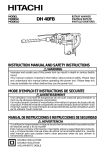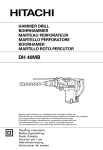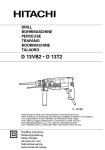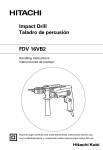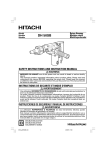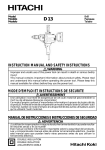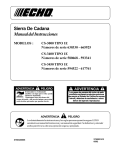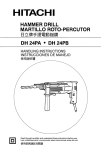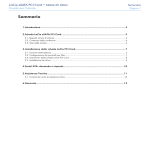Download Hitachi Koki USA DH 40SA User's Manual
Transcript
2 1 3 2 5 A 6 1 4 1 3 4 5 6 7 7 8 9 0 8 A 9 10 12 11 C B 1 D 13 15 14 J G E E H F K I 16 18 17 M J 19 J L N 20 21 O K K J 22 P 73 7 mm 17 mm 2 Q English GENERAL OPERATIONAL PRECAUTIONS WARNING! When using electric tools, basic safety precautions should always be followed to reduce the risk of fire, electric shock and personal injury, including the following. Read all these instructions before operating this product and save these instructions. For safe operations: 1. Keep work area clean. Cluttered areas and benches invite injuries. 2. Consider work area environment. Do not expose power tools to rain. Do not use power tools in damp or wet locations. Keep work area well lit. Do not use power tools where there is risk to cause fire or explosion. 3. Guard against electric shock. Avoid body contact with earthed or grounded surfaces. (e.g. pipes, radiators, ranges, refrigerators). 4. Keep children away. Do not let visitors touch the tool or extension cord. All visitors should be kept away from work area. 5. Store idle tools. When not in use, tools should be stored in a dry, high or locked up place, out of reach of children. 6. Do not force the tool. It will do the job better and safer at the rate for which it was intended. 7. Use the right tool. Do not force small tools or attachments to do the job of a heavy duty tool. Do not use tools for purposes not intended; for example, do not use circular saw to cut tree limbs or logs. 8. Dress properly. Do not wear loose clothing or jewellery, they can be caught in moving parts. Rubber gloves and non-skid footwear are recommended when working outdoors. Wear protecting hair covering to contain long hair. 9. Use eye protection. Also use face or dust mask if the cutting operation is dusty. 10. Connect dust extraction equipment. If devices are provided for the connection of dust extraction and collection facilities ensure these are connected and properly used. 11. Do not abuse the cord. Never carry the tool by the cord or yank it to disconnect it from the receptacle. Keep the cord away from heat, oil and sharp edges. 12. Secure work. Use clamps or a vise to hold the work. It is safer than using your hand and it frees both hands to operate tool. 13. Do not overreach. Keep proper footing and balance at all times. 14. Maintain tools with care. Keep cutting tools sharp and clean for better and safer performance. Follow instructions for lubrication and changing accessories. Inspect tool cords periodically and if damaged, have it repaired by authorized service center. Inspect extension cords periodically and replace, if damaged. Keep handles dry, clean, and free from oil and grease. 15. Disconnect tools. When not in use, before servicing, and when changing accessories such as blades, bits and cutters. 16. Remove adjusting keys and wrenches. Form the habit of checking to see that keys and adjusting 17. 18. 19. 20. 21. 22. wrenches are removed from the tool before turning it on. Avoid unintentional starting. Do not carry a plugged-in tool with a finger on the switch. Ensure switch is off when plugging in. Use outdoor extension leads. When tool is used outdoors, use only extension cords intended for outdoor use. Stay alert. Watch what you are doing. Use common sense. Do not operate tool when you are tired. Check damaged parts. Before further use of the tool, a guard or other part that is damaged should be carefully checked to determine that it will operate properly and perform its intended function. Check for alignment of moving parts, free running of moving parts, breakage of parts, mounting and any other conditions that may affect its operation. A guard or other part that is damaged should be properly repaired or replaced by an authorized service center unless otherwise indicated in this handling instructions. Have defective switches replaced by an authorized service center. Do not use the tool if the switch does not turn it on and off. Warning The use of any accessory or attachment, other than those recommended in this handling instructions, may present a risk of personal injury. Have your tool repaired by a qualified person. This electric tool is in accordance with the relevant safety requirements. Repairs should only be carried out by qualified persons using original spare parts. Otherwise this may result in considerable danger to the user. PRECAUTIONS ON USING HAMMER DRILL 䡬 Wear earplugs to protect your ears during operation. 䡬 Do not touch the bit during or immediately after operation. The bit becomes very hot during operation and could cause serious burns. 䡬 Before starting to break, chip or drill into a wall, floor or ceiling, thoroughly confirm that such items as electric cables or conduits are not buried inside. 䡬 Always hold the body handle and side handle of the power tool firmly. Otherwise the counterforce produced may result in inaccurate and even dangerous operation. 4 English SPECIFICATIONS Voltage (by areas)* (110V, 115V, 120V, 127V, 220V, 230V, 240V) Power input 950 W* Capacity Drill bit: 40 mm Core bit: 105 mm No load speed 360/min. Full-load impact rate 2800/min. Weight (without cord, side handle) 6.5 kg •Be sure to check the nameplate on product as it is subject to change by areas. 䡬 Large dia. hole boring (Rotation + Striking) STANDARD ACCESSORIES (1) Case (Molded plastic) .............................................. 1 (2) Side Handle ............................................................... 1 (3) Stopper ....................................................................... 1 (4) Hexagon Bar Wrench (for 6 mm screw) ............ 1 (5) Hexagon Bar Wrench (for 5 mm screw) ............ 1 (6) Hammer Grease A ................................................... 1 (7) Dust cup ..................................................................... 1 Standard accessories are subject to change without notice. OPTIONAL ACCESSORIES (sold separately) 䡬 Through-hole drilling (Rotation + Striking) (1) Drill bit (hexagon shank) Overall length: 280, 400, 505 mm External dia.: 16, 19, 22, 25, 28, 32, 38 mm 䡬 Anchor hole drilling (Rotation + Striking) Application drill bit Morse taper (No. 1) Drill bit (taper shank) 11, 12, 14.3, 14.5, 17.5 mm Morse taper (No. 2) Drill bit (tape shank) 21.5 mm B-taper 5 (2) Taper shank adapter Taper shank adapter A-taper (Guide plate) (2) Core bit (3) Core bit shank (1) Center pin 䢇 Applied to core bits from 38 mm to 105 mm 䢇 Applied to core bits 32 mm and 35 mm NOTE Do not use core bits 25 mm or 29 mm. (2) Core bit 䢇 External dia. 25, 29, 32, 35, 38, 45, 54, 64, 79, 94, 105 mm (with guide plate, not applicable to cores 25 mm or 29 mm) (3) Core bit shank 䢇 Applied to core bits above 38 mm 䢇 Applied to core bits below 35 mm 䡬 Anchor work (for self-drilling anchors) (1) Anchor adapter (for Rotation + Striking) Anchor sizes: W1/4, W5/16, W3/8, W1/2, W5/8 (No. 20) (No. 25) (No. 30) (No. 40) (No. 50) (3) Cotter (1) Drill bit (taper shank) External dia.: 11, 12, 14. 3, 14.5, 17. 5, 21.5 mm (1) Center pin Taper shank adapter formed Ataper or B-taper is provided as optional accessory, but drill bit for it is not provided. (2) Drift key 䡬 Crushing (Striking) (1) Bull point Overall length: 280, 450 mm 䡬 Groove digging and edging (striking) (1) Cold chisel Overall length: 280, 450 mm English 䡬 Asphalt cutting (striking) (3) Insert the drill bit until it hits the end of the hole, and make sure that the dust cup is not in contact with the tool holder. If the dust cup is found to be in contact with the tool holder, shift it a little forward. (1) Cutter 䡬 Syringe (for chip removal) 䡬 Hammer grease A 500 g (in a can) 30 g (in a green tube) Optional accessories are subject to change without notice. APPLICATIONS 䡬 Drilling holes in concrete 䡬 Drilling anchor holes 䡬 Crushing concrete, chipping, digging, and squaring (by applying optional accessories) PRIOR TO OPERATION 1. Power source Ensure that the power source to be utilized conforms to the power requirements specified on the product nameplate. 2. Power switch Ensure that the power switch is in the OFF position. If the plug is connected to a power receptacle while the power switch is in the ON position, the power tool will start operating immediately, which could cause a serious accident. 3. Extension cord When the work area is removed from the power source, use an extension cord of sufficient thickness and rated capacity. The extension cord should be kept as short as practicable. 4. How to install tool NOTE For tools such as a bull point and a cold chisel, use only Hitachi genuine parts. (1) Clean, then smear the tool shank with the grease provided in the green tube (Fig. 1). (2) The grip can be rotated manually at an 60° angle. Fully turn the grip in the direction of the arrow A mark on the grip as shown in Fig. 2 so that the mark on the front sleeve. is aligned with the (Fig. 2) (3) Insert the shank of the tool until it makes contact with the back side of the hole. (Fig. 2) ” so that (4) Turn the grip in the direction of “Lock the mark on the grip is aligned with the mark on the front sleeve. The tool is locked. Remove the drill bit in the reverse order. (Fig. 2) 5. Fixing Dust cup When a worker is engaged in an operation with the main body faced upward, if a dust cup is fixed to a drill bit, the inside of a tool holder can be prevented from any possible invasion of dust. The dust cup should be fixed as explained below. (1) Insert the dust cup into the drill bit. (Fig. 3) (2) Fix the drill bit to the tool holder. (Fig. 4) HOW TO USE THE HAMMER DRILL 1. How to drill holes (Fig. 5) (1) Pull the switch trigger after applying the drill bit tip to the drilling position. (2) It is unnecessary to forcibly press the hammer drill main body. It is sufficient to slightly press the hammer drill to an extent that shavings are freely discharged. CAUTION Although this machine is equipped with a safety clutch, if the drill bit becomes bound in concrete or other material, the resultant stoppage of the drill bit could cause the machine body to turn in reaction. Ensure that the main handle and side handle are gripped firmly during operation. 2. How to chip or crush (Fig. 6) By applying the drill bit tip to the chipping or crushing position, operate the hammer drill by utilizing its empty weight. Forcible pressing or thrusting is unnecessary. 3. Install the stopper (Fig. 7) (1) Loosen the side handle and insert the straight portion of the stopper into the handle bolt hole. (2) Move the stopper to the specified position and rotate the side handle clockwise to fix the stopper. 4. Warming up (Fig. 8) The grease lubrication system in this unit may require warming up in cold regions. Position the end of the bit so makes contact with the concrete, turn on the switch and perform the warming up operation. Make sure that a hitting sound is produced and then use the unit. CAUTION When the warming up operation is performed, hold the side handle and the main unit securely with both hands to maintain a secure grip and avoid being turned around by the drill. DRILLING AND DRIVING-IN OPERATIONS FOR ANCHORS Use the optional accessories for anchors, such as anchor adapter and taper shank adapter. 1. When a rotation striking anchor adapter is used. (1) Install the self-drilling anchor in the anchor adapter (Fig. 9). (2) Turn ON the switch and drill a base hole with the self-drilling anchor. (Fig. 10) At the start of the hole-drilling slightly tilt the hammer drill to determine the hole position. (3) After cleaning out dust with a syringe, attach the plug to the anchor tip and drive in the anchor with a manual hammer. (4) After driving in the anchor, use the drift key to separate the anchor. (Fig. 11) (5) By employing a manual hammer or pliers, snap off the tapered portion of the anchor. (Fig. 12) CAUTION Since the snapped-off tapered portion will fly out, pay attention to the snapping direction. 6 English 2. When a taper shank adapter is used. (Fig. 13) (1) Install drill bit with taper shank in the taper shank adapter. (2) Turn the power on and drill a base hole to the depth sounded by indicating groove on the drill bit. (3) After cleaning out dust with a syringe, attach the plug to the anchor tip and drive in the anchor with a manual hammer. (4) To remove the drill bit (taper shank), insert the cotter into the slot of the taper shank adapter and strike the head of the cotter with a hammer supporting on a rest. (Fig. 14) HOW TO HANDLE A CORE BIT When a core bit is used, large caliber holes and blind holes can be drilled. In this case, use optional accessories for core bits (such as a center pin and core bit shank) for more rational operation. 1. Mounting CAUTION Prior to mounting a core bit, always disconnect the plug from the power supply receptacle. (1) Mount the core bit on the core bit shank. (Fig. 15) Before that, feed oil to the screw portion of core bit shank for easy dismount. (2) Mount the core bit shank on the drill main body in the same manner as in mounting the drill bit and the bull point. (Fig. 16) (3) Insert the center pin into the guide plate until it reaches the extremity. (4) Fit in the guide plate by aligning its concaved portion with the core bit tip. When the position of the concave is shifted by turning the guide plate right or left, the guide plate never slips off even when the drill is used in a downward direction. (Fig. 17) 2. Drilling holes (1) Insert the plug into a power supply receptacle. (2) A spring is built in the center pin. By straightly and gently pressing it to the wall or floor surface, the entire surface of the core bit tip attains contact to start the hole drilling job. (Fig. 18) (3) When the hole depth reaches approximately 5 mm, the hole position can be determined. Then remove the center pin and guide plate from the core bit and continue the hole drilling job. CAUTION When removing the center pin and guide plate, always disconnect the plug from the power supply receptacle. 3. How to dismount the core bit 䡬 By holding the drill (with the core bit inserted) in an upward position, drive the drill to repeat impact operation two or three times, whereby the screw is loosened and the drill becomes ready for disassembly. (Fig. 19) 䡬 Remove the core bit shank from the drill, hold the core bit with one hand, and strongly strike the head of the hexagonal portion of the core bit shank with a manual hammer two or three times, whereby the round head screw is loosened and the drill is ready for disassembly. (Fig. 20) 7 HOW TO REPLACE GREASE This machine is of full air-tight construction to protect against dust and to prevent lubricant leakage. Therefore, the machine can be used without lubrication for long periods. Replace the grease as described below. 1. Grease replacement period After purchase, replace grease after every 6 months of usage. Ask for grease replacement at the nearest authorized Hitachi Service Agent. Proceed for replacement of grease. 2. Grease replacement CAUTION Before replacing the grease, turn the power off and pull out the power plug. (1) Remove the crank case cover and wipe off the grease inside. (Fig. 21) (2) Supply 20g of Hitachi Electric Hammer Grease A (Standard accessory, contained in tube) to the crank case. As the tube contain 30g of grease, supply 2/3 of the contained grease. (3) After replacing the grease, install the crank case cover securely. NOTE The Hitachi Electric Hammer Grease A is of the low viscosity type. If necessary purchase from an authorized Hitachi Service Agent. MAINTENANCE AND INSPECTION 1. Inspecting the tool Since use of a dull tool will degrade efficiency and cause possible motor malfunction, sharpen or replace the tool as soon as abrasion is noted. 2. Inspecting the mounting screws: Regularly inspect all mounting screws and ensure that they are properly tightened. Should any of the screws be loose, retighten them immediately. Failure to do so could result in serious hazard. 3. Maintenance of the motor The motor unit winding is the very “heart” of the power tool. Exercise due care to ensure the winding does not become damaged and/or wet with oil or water. 4. Inspecting the carbon brushes (Fig. 22) The Motor employs carbon brushes which are consumable parts. When they become worn to or near the “wear limit”, it could result in motor trouble. When an auto-stop carbon brush is equipped, the motor will stop automatically. At that time, replace both carbon brushes with new ones which have the same carbon brush Numbers shown in the figure. In addition, always keep carbon brushes clean and ensure that they slide freely within the brush holders. 5. Replacing carbon brushes Loosen the two set screws and remove the tail cover. Remove the brush caps and carbon brushes. After replacing the carbon brushes, tighten the brush caps securely and install the tail cover with securely tightening two set screws. NOTE Due HITACHI’s continuing program of research and development, the specifications herein are subject to change without prior notice. Español PRECAUCION ES GENERAL ES PARA OPERACIÓN ¡ADVERTENCIA! Cuando utilice herramientas eléctricas, tome las medidas de seguridad básicas para reducir el riesgo de incendios, descargas eléctricas, y lesiones, incluyendo lo siguiente. Lea todas todas estas instrucciones antes de utilizar este producto y guárdelas. Para realiza roperaciones seguras: 1. Mantener el área de trabajo limpia, áreas y bancos de trabajo desordenados son causa de da ños personales. 2. Considerar el medio ambiente del área de trabajo. No exponer las herramientas eléctricas a la lluvia. No usar herramientas eléctricas en lugares mojados o húmedos. Mantener el área de trabajo bien iluminada. No utilice herramientas eléctricas cuando exista el riesgo de incendios o de explosión. 3. Protegerse contra descargas eléctricas. Evitar el contacto del cuerpo con las superficies puestas a tierra. (p. ej., tubos, radiadores, hornos de microondas, o refrigeradores.) 4. Mantener a los ni ños alejados. No dejar que los visitantes toquen las herramientas ni los cables de extensión. Todos los visitantes deberán mantenerse alejados del área de trabajo. 5. Guardar las herramientas que no se usen y ponerlos en lugares secos, altos o cerrados, fuera del alcance de los ni ños. 6. No forzar las herramientas, éstas trabajarán más y con mayor seguridad cuando cumplan con las especificaciones para las cuales fueron diseñadas. 7. Usar las herramientas apropiadas. No forzar pequeñas herramientas o accesorios a realizar el trabajo de herramientas de mayor potencia. No utilizar herramientas para otros propósitos para los cuales no fueron dise ñadas, por ejemplo, no utilizar sierras circulares para cortar ramas de árboles o troncos. 8. Vestir apropiadamente. No ponerse ropas que queden flojas ni tampoco joyas. Estas podrian quedar atrapadas en las partes móviles de las herramientas. Cuando se trabaje en exteriores, se recomienda el uso de guantes de goma y calzado que no resbale. 9. Usar gafas de protección. Usar también mascarillas contra el polvo si las condiciones de corte fuesen polvorientas. 10. Conecte un equipo colector de polvo. Si existen dispositivos para la conexión de equipos de extracción y recolección de polvo, cerciórese de queéstos estén conectados adecuadamente, y de utilizarlos en la forma correcta. 11. Cuidar del cable. Nunca lleve las herramientas colgando del cable, tampoco tire del cable para efectuar la desconexión de las herramientas. Mantener el cable alejado del calor, aceite y bordes agudos. 12. Asegurar la pieza de trabajo usando para ello abrazaderas o un tornillo. Esto es más seguro que usar las manos, ademas, ambas manos quedan libres para operar la herramienta. 13. No extenderse excesivamente para efectuar un trabajo. Mantener en todo momento un buen balance y base de apoyo. 14. 15. 16. 17. 18. 19. 20. 21. 22. Mantener cuidadosamente las herramientas.Tener las siempre limpias y afiladas para obtener un mejor rendimiento y un funcionamiento más seguro. Seguir siempre las instrucciones para la lubricación y el cambio de accesorios. Inspeccionar periódicamente los cables de las herramientas y si estuviesen da nãdos, hacer que los reparen técnicos ó expertos. Inspeccionar periodicamente los cables de extensión y cambiarlos si estuviesen da ñados. Mantener los mangos secos, limpios, y libres de aceite y grasa. Desconectar las herramientas cuando no se usen, antes de repararlas, y cuando se cambien accesorios como por ejemplo, cuchillas, brocas, cortadores, etc. Quitar las cuñas y las llaves de tuercas. Acostumbrarse a comprobar si se han quitado las cu ñas y las llaves de tuercas antes de poner las harramientas en funcionamiento. Evitar puestas en funcionamiento sin fin alguno. No llevar las herramientas con los dedos en los inerruptores mientras que éstas cstán conectadas. Cuando se conecten las herramientas, cerciorarse de que los interruptores esten en la posición de desconectados. Para usos en exteriores usar cables de extensión. Cuando las herramientas vayan a ser usadas en exteriores, usar solamente cables de extensión diseñados para tal propósito. Estar siempre alerta y poner atención a lo que se está haciendo, usar el sentido común y no operar con la herramienta cuando se esté cansado. Comprobar las piezas dañadas. Antes de seguir con el funcionamiento de las herramientas, las piezas que estén dañadas deberán comprobarse cuidadosamente para determinar si pueden funcionar apropiadamente y cumplir con la función para las que fueron dise ñadas. Comprobar el alineamiento y agarrotamiento de piezas móviles, rotura de piezas, montura, y cualiquier otra anomalia que pudiese afectar al rendimiento de la herramienta. Cualquier pieza que estuviese da ñada deberá repararse apropiadamente o cambiarse en un centro de reparaciones autorizado, al menos que se indique, lo contrario en este manual de instrucciones. Procurar que los interruptores defectuosos los cambie un centro de reparaciones autorizado. No usar las herramientas si sus interruptores no funcionasen apropiadamente. Advertencia La utilización de cualquier accesorio o aditivo no recomendado en este manual de instrucciones puede conducir al riesgo de lesiones. En caso de avería, haga que su herramienta sea reparada por un técnico cualificado. Esta herramienta eléctrica está de acuerfdo con los requisitos de seguridad pertinentes. Las reparaciones solamente deberán realizarlas técnicos cualificadosutilizando piezas de repuesto originales. De lo contrario, el usuario podría lesionarse. 8 Español PRECAUCIONES AL USAR EL MARTILLO ROTO-PERCUTOR 䡬 Usar protectores de oídos durante el trabajo. 䡬 No tocar la broca durante ni inmdiatamente después de trabajar, puesto que se pone ardiente y puede causar quemaduras serias. 䡬 Antes de empezar a romper, picar o perforar en una pared, suelo o techo, comprobar cuidadosamente que no hayan objetos empotrados, tales como cables o conductos eléctricos. 䡬 Sujetar siempre firmemente al asidero del cuerpo y el asidero lateral de la harrmienta. De lo contrario, la contrafuerza producida podría causar un funcionamiento impreciso e incluso peligroso. ESPECIFICACIONES Voltaje (por áreas)* (110V, 115V, 120V, 127V, 220V, 230V, 240V) Entrada 950 W* Capacidad Barrena: 40 mm Barrena tubular: 105 mm Velocidad sin carga 360/min. Impacto a carga plena 2800/min. Peso (sin cable ni mango lateral) 6,5 kg * Verficar indefectiblemente los datos de la placa de características de la máquina, pues varían de acuerdo al país de destino. ACCESORIOS ESTANDAR (1) (2) (3) (4) Caja (Plástica) ............................................................. 1 Mango lateral ............................................................. 1 Tope ............................................................................. 1 Llave de barra hexagonal ........................................ 1 (para tornillos de 6 mm) (5) Llave de barra hexagonal ....................................... 1 (para tornillos de 5 mm) (6) Grasa A para martillo ............................................. 1 (7) Copa para el polvo ................................................... 1 Los accesorios estándar están sujetos a cambios sin previo aviso. Adaptador de espiga cónica Barrena aplicable Cono Morse (N°. 1) Barrena (espiga cónica) 11 12 14,3 14,5 17,5 mm Cono Morse (N°. 2) Barrena (espiga cónica) 21,5 mm Cono A Cono B Adaptador de espiga cónica formada por el dispositivo ahusador A o el B, provisto como accesorio opcional, pero no se provee barrena de perforar. 䡬 Perforación de orificio de diámetro grande (Rotación + percusión) ACCESORIOS FACULTATIVOS (de venta por separado) 䡬 Perforación por orificio (Rotación + percusión) (Placa guía) (1) Barrena (espiga hexagonal) Longitud total: 280 400 505 mm Diámetro externo: 16 19 22 25 28 32 38 mm 䡬 Perforación de orificio de anclaje (Rotación + percusión) (3) Cortadora (1) Barrena Diàmetro externo: 11 12 14,3 14,5 17,5 21,5 mm 9 (2) Adaptador de espiga cónica (1) Pasador contral (2) Barrena (3) Espiga de barrena tubular (1) Pasador central 䢇 Aplicable a barrenas de 38 mm ~ 105 mm 䢇 Aplicable a barrenas de 32 mm y 35 mm NOTA No usar barrenas de 25 y 29 mm (2) Barrena 䢇 Diámetro externo 25 29 32 35 38 45 54 64 79 94 105 mm (Con placa guía no aplicable a barrenas de 25 y 29 mm) (3) Espiga de barrena tubular 䢇 Aplicable a barrenas de más de 38 mm 䢇 Aplicable a barrenas de menos de 35 mm 䡬 Trabajo de anclaje (para anclajes de perforado propio) Español (1) Adaptador de anclaje (para rotación + percusión) Tamaño de anclaje: W1/4, W5/16, W3/8, W1/2, W5/8 (N°. 20) (N°. 25) (N°. 30) (N°. 40) (N°. 50) (2) Cuña sacabarrenas 䡬 Romper (Percusión) (1) Puntero Largo total: 280 450 mm 䡬 Excavar, ranurado y rebordes (percusión) (1) Cortafrio Largo total: 280 450 mm 䡬 Corte de asfalto (percusión) (1) Cortadora 䡬 Jeringa (extracción de resíduos) 䡬 Grasa A para martillo 500 g (en una lata) 30 g (en un tubo naranja) Los accesorios facultativos están sujetos a cambios sin previo aviso. APLICACIONES 䡬 Perforación de orificios en concreto 䡬 Perforación de orificios de anclaje 䡬 Romper hormigón, picar, cavar y cuartear (con accesorios opcionales). ANTES DE LA PUESTA EN MARCHA 1. Alimentación Asegurarse de que la alimentacion de red que ha de ser utilizada responda a las exigencias de corriente especificadas en la placa de características del producto. 2. Conmutador de alimentación Asegurarse de que el conmutador de alimentación esté en la posición OFF (desconectado). Si la clavija está conectada en la caja del enchufe mientras el conmutador de alimentación esté en posición ON (conectado) las herramientas eléctricas empezarán a trabajar inmediatamente, provocando un serio accidente. 3. Cable de prolongación Cuando está alejada el área de trabajo de la red de alimentación, usar un cable de prolongación de un grosor y potencia normal suficiente. El cable de prolongación debe ser mantenido lo más corto posible. 4. Montaje de la herramienta NOTA Para usar herramientas tales como el puntero y cortafrío, usar siempre piezas genuinas Hitachi. (1) Limpiar y engrasar la espiga con la grasa provista (Fig. 1) (2) El sujetador podrá girarse manualmente con un ángulo de 60° en cualquier sentido. Gire completamente el sujetador en el sentido de la flecha A como se muestra en la Fig. 2 de forma del mismo quede alineada con que la marca del manguito frontal. (Fig. 2) la marca (3) Inserte el vástago de la herramienta hasta que entre en contacto con la parte posterior del orificio. (Fig. 2) (4) Gire el sujetador en el sentido de “Lock ” de del sujetador quede alineado forma que la marca del manguito frontal. La con la marca herramienta quedará bloqueada. Quite la broca en orden inverso. (Fig. 2) 5. Fijación de la copa para el polvo Cuando el operario trabaje sobre el nivel de los ojos, si fija una copa para el polvo en la broca, se impedirá que entre polvo en el interior del portabrocas. La copa para el polvo deberá fijarse como se explica a continuación. (1) Inserte la copa para el polvo en la broca. (Fig. 3) (2) Fije la broca al protabrocas. (Fig. 4) (3) Inserte la broca hasta que toque el extremo del orificio, y cerciórese de que la copa para el polvo no quede en contacto con el protabrocas. Si la copa para el polvo está en contacto con el portabrocas, deslícela un poco hacia adelante. MODO DE UTILIZACION 1. Taladrar orificios (Fig. 5) (1) Oprimir el interruptor de operación luego de apoyar la punta de la barrena en la posición de taladrar. (2) No es necesario presionar el cuerpo principal del martillo perforador. Es suficiente con empujar ligeramente el martillo de taladrar teniendo en cuenta que los materiales saltan libremente, al taladrar. PRECAUCION Aunque este aparato se equipa con un embrague de seguridad, si se atasca la barrena de taladrar en el hormigón u otro material semejante, puede pasar que, al atascarse la barrena, el cuerpo del martillo gire en dirección opuesta. Asegurarse entonces de que el mango principal y el lateral están bien empuñados durante el uso de esta herramienta. 2. Forma de picar o romper (Fig. 6) Aplicando la punta de la barrena en posición de picar o romper, hacer funcionar el martillo perforador aplicando su propio peso. No es necesario presionar o empujar excesivamente. 3. Instalar el tope (Fig. 7) (1) Alfojar el mango lateral e insertar la parte recta del tope en el orificio del perno de manija. (2) Aflojar el mango lateral, y mover el tope a la posición especificada y rotar el mango lateral a la derecha para fijar el tope. 4. Calentamiento (Fig. 8) El sistema de lubricación de esta unidad puede requerir calentamiento en ciertas regiones. 10 Español Coloque el extremo de la broca de forma que entre en contacto con el hormigón, ponga en ON el interruptor de alimentación principal de la unidad, y realice la operación de calentamiento. Cerciórese de que se produzca un sonido de martilleo, y después utilice la unidad. PRECAUCION Cuando haya realizado la operación de calentamiento, sujete con seguridad el mango lateral y la unidad principal con ambas manos para asegurar una buena sujeción y evitar que la m†quina le haga girar. PERFORACION E INCRUSTACION DE ANCLAJES Usar los accesorios opcionales para los anclajes, tales como adaptador de anclaje y adaptador de espiga cónica. 1. Cuando se use adaptador de anclaje de rotaciónpercusión. (1) Instalar el anclaje de perforación propia en el adaptador de anclaje. (Fig. 9) (2) Poner el interruptor en “ON” y perforar un agujero base con el anclaje de auto-perforación (Fig. 10) Al comienzo de la perforación del orificio, inclinar ligeramente la herramienta para determinar bien la posición del orificio. (3) Después de limpiar el polvo con una jeringa, colocar el tapón en la punta del anclaje y meterlo con un martillo manual. (4) Luego de insertar el anclaje, usar la cuña sacabarrenas para separar el anclaje. (Fig. 11) (5) Empleando un martillo manual sacar de un glope la parte cónica del anclaje. (Fig. 12) PRECAUCION Debido a que esta parte sobrante saltará al golpearla, prestar atención a su dirección. 2. Cuando se use un adaptador de espiga cónica (Fig. 13) (1) Instalar la barrena en el adaptador de espiga cónica. (2) Conectar el aparato y perforar un orificio base a una profundidad correspondiente a la ranura indicadora del tope en el orificio del perno de manija por la de la barrena. (3) Luego, limpiar el polvo con una jeringa, colocar el tapón en la punta del anclaje e instertar éste con un martillo manual. (4) Para quitar la broca (espiga ahusada), insertar la chaveta en la ranura del adaptador de la espiga ahusada y golperar la cabeza de la chaveta con un martillo. Usar apoyos como se muestra en la Fig. 14. USO DE BARRENA TUBULAR Cuando se usa una barrena tubular, pueden perforarse orificios grandes y orificios ciegos. En este caso, hay que emplear los accesorios opcionales para barrenas tubulares (tales como el pasador central y la espiga de barrena tubular) para trabajar de modo más racional. 1. Montaje PRECAUCION Antes de montar una barrena tubular, siempre hay que desenchufar el aparato del tomacorriente de la pared. 11 (1) C o l o c a r l a b a r r e n a t u b u l a r e n l a e s p i g a correspondiente (Fig. 15). Antes de ello, agregar aceite en la parte de rosca de la barrena tubular para facilitar el desmontaje. (2) Colocar la barrena tubular en el cuerpo principal del taladro del mismo modo que se hizo con la barrena y el puntero (Fig. 16) (3) Insertar el pasador central en la placa guía gasta que alcance la extremidad. (4) Colocar la placa quía alineando su parte cóncava con la punta de la barrena tubular. Cuando la posición de la parte cóncava se cambia, girando la placa guía a derecha o izquierda, ésta nunca debe salirse, aún cuando el taladro se use en dirección hacia abajo (Fig. 17). 2. Perforación (1) Enchufar el aparato en el tomacorriente de pared. (2) El pasador central tiene un resorte incluido y, presionándolo levemente y en forma recta, se pone en contacto toda la superficie de la punta de la barrena para comenzar a taladrar. (Fig. 18) (3) Cuando el orificio alcanza una profundidad de 5 mm la posición del orificio puede determinarse perfectamente. Luego, quitar el pasador central y la placa guía de la barrena tubular y continuar taladrando. PRECAUCION Cuando se quita el pasador central y la placa guía, siempre hay que desenchufar el aparato del tomacorriente. 3. Desmontaje de la barrena tubular 䡬 Sosteniendo el taladro (con la barrena tubular puesta) en posición invertida, accionar el taladro para que repita la operación de impacto dos o tres veces con ello, se afloja el tornillo y el taladro queda listo para desarmarse. (Fig. 19) 䡬 Quitar la espiga de la barrena tubular del taladro, sosteniendo la barrena tubular con una mano y golpear con fuerza la cabeza de la parte hexagonal de la espiga de la barrena tubular, con la mano dos o tres veces, para aflojar el tornillo de cabeza redonda, con lo cual, el taladro queda listo para desarmarse. (Fig. 20) CAMBIO DE GRASA Esta máquina es de construcción completamente cerrada, para evitar que entre polvo y haya fugas de lubricante. Por ello, la herramienta puede usarse sin lubricarse por largos periodos. Cuando so requiere cambiar la grasa, proceder como sigue: 1. Período de cambio de grasa: Luego de adquirir la herramienta, cambiarle la grasa cada 6 meses de uso. Consultar para ello con el agente de servicio Hitachi autorizado. Procedimiento de cambio de grasa. 2. Cambio de grasa PRECAUCION Antes de cambiar la grasa, desconectar el aparato y desenchufarlo del tomacorriente. (1) Quitar la cubierta del cigüeñal y limpiar la grasa interna. (Fig. 21) Español (2) Aplicar 20g de grasa para martillo eléctrico Hitachi tipo A (accesorio normales, contenida en tubo) en el cárter. Como el tubo contiene 30g de grasa, proveer 2/3 de la grasa contenida. (3) Luego de cambiar la grasa, instalar la cubierta del cigüeñal firmemente. NOTA La grasa A del martillo eléctrico Hitachi es del tipo de baja densidad. Si es necesario, siempre adquirir la grasa a un agente de servicio Hitachi autorizado. MANTENIMIENTO E INSPECCION 1. Inspección d la herramienta Ya que la utilización de una herramienta de corte embotada disminuirá la eficiencia de trabajo y podría causar desperfectos en el motor, afilar o cambiar las herramientas de corte tan pronto como se note abrasión en éstas. 2. Inspeccionar los tornillos de montaje: Regularmente inspeccionar todos los tornillos de montaje y asegurarse de que estén apretados firmemente. Si cualquier tornillo estuviera suelto, volver a apretarlo inmediatamente. El no hacer esto provocaría un riesgo serio. 3. Mantenimiento de motor: La unidad de bobinado del motor es el verdadero “corazón” de las herramientas eléctricas. Prestar el mayor cuidado y asegurarse de que el bobinado no se dañe y/o se humedezca con aceite o agua. 4. Inspeccionar los carbones de contacto (Fig. 22) El motor emplea escobillas de carbón que son partes consumibles. Cuando se gastan o están cerca del “limite de desgaste” pueden causar problemas al motor. Al equiparse la escobilla de carbón de parada automática, el motor se detendrá automáticamente en ese momento hay que proceder a cambiar ambas escobillas de carbón por la nuevas, que tienen los mismos números de escobillas de carbón como se muestra en la figura. Además siempre hay hay que mantener las escobillas de carbón limpias y asegurarse de que se muevan libremente en sus porta-escobillas. 5. Cambio de escobillas de carbón Quitar la cubierta de cola y luego aflojar el tornillo de fijación. Aflojando la tapa de escobilla, pueden quitarse las escobillas de carbón, al colocar las escobillas, apretar firmemente la tapa de escobillas y recolocar la cubierta de con dos tornillos. OBSERVACION Debido al programa continuo de investigación y desarollo de HITACHI estas especificaciones están sujetas a cambio sin preaviso. 12 18 The exploded assembly drawing should be used only for authorized service center. Item No. 1 2 3 4 5 6 7 8 9 10 11 12 13 14 15 16 17 18 19 20 21 23 24 25 26 27A 28 29 30 31 32 33 35 36 37 38 39 40 41 42 43 44 45 46 47 48 49 50A 51 52 53 54 55 56 Part Name C-Type Spring Steel Ball Front Cap Retaining Ring Front Washer (A) Damper Ring Front Washer (B) Grip Saddle Key Saddle Key Holder Retaining Ring For D38 Shaft Rubber Ring Nylock High Tension Bolt Front Sleeve Front Cover O-Ring (1AS-60) O-Ring (C) Second Hammer Damper Washer Damper Washer Feather Key Oil Seal (A) Ball Bearing (6002DDUCMP2S) Washer Washer (A) Gear Holder Spring (C) Needle Pin Second Gear Spacer Ball Bearing (629VVMC2EPS2L) Nylock Bolt (W/Flange) Distance Piece (B) Crank Case Cover Ass’y Rubber Seal Crank Case Retaining Ring For D12 Shaft Crank Shaft Feather Key Ball Bearing (6204VVCMPS2S) Oil Seal (B) Bearing Cover Nylock Hex. Socket Hd. Bolt Needle Bearing (M661) First Gear Seal Packing Gear Cover Ass’y Feather Key Sylinder Valve Band Striker O-Ring Piston D7.0 D32 M7×25 3×3×8 D6×6 M5×16 3×3×10 M5×16 3×3×20 Item No. 57 58 59 60 61 62 63 65 66 67 68 69 70 71 72 73 74 75 76 77 78A 79 80 81 82 83 84 85 86 87 88 89 90 91 92 93 94 95 96 97 98 99 100 101 102 103 104 105 106 501 502 503 504 505 Part Name Piston Pin Connecting Rod Ass’y Needle Bearing (NSK AJ50 1203) Nylock Bolt (W/Flange) M6×25 Cylinder Case O-Ring (1AS-60) Needle Bearing (B) (NTN HMK4520) Side Handle Handle Holder Handle Bolt Stopper Rod Ball Bearing (6202VVCMPS2S) Dust Washer O-Ring Hex. Hd. Tapping Screw D5×55 Dust Washer (A) Ball Bearing (629VVMC2EPS2L) Housing HITACHI Label Brush Cap Carbon Brush (Auto Stop Type) Brush Holder Nylock Bolt (W/Flange) M5×25 Hex. Socket Set Screw M5×8 Bearing Holder Tail Cover Tapping Screw (W/Flange) D5×20 Fan Armature Ass’y Stator Ass’y Brush Terminal Handle Switch (C) Handle Cover Tapping Screw (W/Flange) D4×20 Terminal Cord Clip Tapping Screw (W/Flange) D4×16 Cord Tapping Screw (W/Flange) D5×25 Name Plate Cord Armor Plug (A) Plug (B) Connector (50092) Pillar Terminal Bearing Washer (C) Bevel Gear Pinion Set Bevel Gear Clutch Ass’y Case Grease (A) Hex. Bar Wrench 4MM Hex. Bar Wrench 5MM Dust Cup Parts are subject to possible modification without notice due to improvements. 20 901 Code No. C99075332 N Printed in Japan
This document in other languages
- español: Hitachi Koki USA DH 40SA























